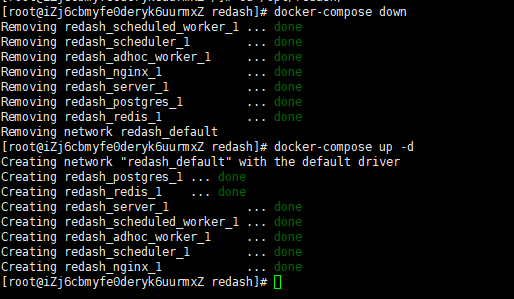Just in case anyone else wants to install Redash (using docker), on CentOS 7 instead of Ubuntu, this is an updated version of setup.sh with the needed pieces:
#!/usr/bin/env bash
# This script sets up dockerized Redash on CentOS 7 and Ubuntu 18.04.
set -u
REDASH_BASE_PATH=/opt/redash
COMPOSE_PATH=/usr/local/bin/docker-compose
distro=unknown
install_docker(){
# Check for CentOS vs Ubuntu, then install Docker as appropriate
which yum >/dev/null 2>&1
if [ $? -eq 0 ]; then
distro=centos7
sudo yum -y update
sudo yum -y install https://dl.fedoraproject.org/pub/epel/epel-release-latest-7.noarch.rpm
sudo curl -L -o /etc/yum.repos.d/docker-ce.repo https://download.docker.com/linux/centos/docker-ce.repo
sudo chown root:root /etc/yum.repos.d/docker-ce.repo
sudo restorecon -Fv /etc/yum.repos.d/docker-ce.repo
sudo yum -y install docker-ce pwgen yajl
sudo systemctl start docker
else
distro=ubuntu
sudo apt-get update
sudo apt-get -yy install apt-transport-https ca-certificates curl software-properties-common pwgen
curl -fsSL https://download.docker.com/linux/ubuntu/gpg | sudo apt-key add -
sudo add-apt-repository "deb [arch=amd64] https://download.docker.com/linux/ubuntu $(lsb_release -cs) stable"
sudo apt-get update && sudo apt-get -y install docker-ce
fi
# Install Docker Compose
sudo curl -L https://github.com/docker/compose/releases/download/1.22.0/docker-compose-$(uname -s)-$(uname -m) -o ${COMPOSE_PATH}
sudo chmod +x ${COMPOSE_PATH}
if [ "${distro}" = "centos7" ]; then
sudo restorecon -Fv ${COMPOSE_PATH}
fi
# Allow current user to run Docker commands
sudo usermod -aG docker $USER
}
create_directories() {
if [[ ! -e $REDASH_BASE_PATH ]]; then
sudo mkdir -p $REDASH_BASE_PATH
sudo chown $USER:$USER $REDASH_BASE_PATH
fi
if [[ ! -e $REDASH_BASE_PATH/postgres-data ]]; then
mkdir $REDASH_BASE_PATH/postgres-data
fi
}
create_config() {
if [[ -e $REDASH_BASE_PATH/env ]]; then
rm $REDASH_BASE_PATH/env
touch $REDASH_BASE_PATH/env
fi
COOKIE_SECRET=$(pwgen -1s 32)
POSTGRES_PASSWORD=$(pwgen -1s 32)
REDASH_DATABASE_URL="postgresql://postgres:${POSTGRES_PASSWORD}@postgres/postgres"
echo "PYTHONUNBUFFERED=0" >> $REDASH_BASE_PATH/env
echo "REDASH_LOG_LEVEL=INFO" >> $REDASH_BASE_PATH/env
echo "REDASH_REDIS_URL=redis://redis:6379/0" >> $REDASH_BASE_PATH/env
echo "POSTGRES_PASSWORD=$POSTGRES_PASSWORD" >> $REDASH_BASE_PATH/env
echo "REDASH_COOKIE_SECRET=$COOKIE_SECRET" >> $REDASH_BASE_PATH/env
echo "REDASH_DATABASE_URL=$REDASH_DATABASE_URL" >> $REDASH_BASE_PATH/env
}
setup_compose() {
# Determine newest release of Redash
REQUESTED_CHANNEL=stable
if [ "${distro}" = "centos7" ]; then
PRETTY_PRINTER=json_reformat
else
PRETTY_PRINTER=json_pp
fi
LATEST_VERSION=`curl -s "https://version.redash.io/api/releases?channel=$REQUESTED_CHANNEL" | ${PRETTY_PRINTER} | grep "docker_image" | head -n 1 | awk 'BEGIN{FS=":"}{print $3}' | awk 'BEGIN{FS="\""}{print $1}'`
# Update version string in the docker-compose yaml
cd $REDASH_BASE_PATH
REDASH_BRANCH="${REDASH_BRANCH:-master}" # Default branch/version to master if not specified in REDASH_BRANCH env var
curl -OL https://raw.githubusercontent.com/getredash/redash/${REDASH_BRANCH}/setup/docker-compose.yml
sed -ri "s/image: redash\/redash:([A-Za-z0-9.-]*)/image: redash\/redash:$LATEST_VERSION/" docker-compose.yml
echo "export COMPOSE_PROJECT_NAME=redash" >> ~/.profile
echo "export COMPOSE_FILE=${REDASH_BASE_PATH}/docker-compose.yml" >> ~/.profile
export COMPOSE_PROJECT_NAME=redash
export COMPOSE_FILE=${REDASH_BASE_PATH}/docker-compose.yml
# Start the Redash containers
sudo ${COMPOSE_PATH} run --rm server create_db
sudo ${COMPOSE_PATH} up -d
}
install_docker
create_directories
create_config
setup_compose
# Make the new docker user group effective, so the user doesn't need to re-login
exec sg docker newgrp `id -gn`
Apologies for doing it inline like that. The forum doesn’t seem to allow non-image file attachments. 






